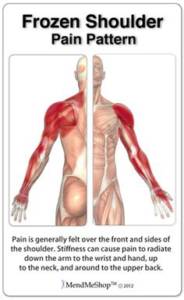What is Frozen Shoulder? aka Adhesive Capsulatis
I have had clients and have clients who knew they had frozen shoulder, there were those who had it and didn’t know what it was.
Frozen shoulder can be a disabling condition characterized by pain, inflammation, stiffness and limited range of motion in the shoulder joint. As a massage therapist, I have noticed that most people who have frozen shoulder complain about the pain in their pectoral muscle/front of the deltoid area, and back of the shoulder- part of the shoulder blade, in essence both “sides” of the shoulder. Furthermore they have difficulty lifting their hand up above their ears and above their head(as to reach for something in a higher shelf) and also difficulty to put it behind their back easily. And it appears and feels to be “frozen” when trying to move it.

Frozen Shoulder
The first symptoms are pain and an inability to perform daily tasks such as reaching or lifting. The onset of frozen shoulder is gradual and symptoms may last from 1-2 months to over 3 years, depending on treatment. Noteworthy the recurrence of Adhesive Capsulitis is uncommon once a frozen shoulder receives treated and heals. However, a small percentage of patients develop it in the opposite shoulder within 5 years.
Who Gets It
Could be anyone however these are the group of people in higher risk bracket:
- Individuals between the ages of 40-65
- Women (60-70% of cases)
- People with poor posture
- Those engaged in regular overuse of shoulder muscles (in sports, manual labor, etc.)
- People with recent shoulder injuries
- Patients recovering from shoulder or reconstructive breast surgeries
- Family members with a history of frozen shoulder issues (genetic component)
- Frozen shoulder currently affects around 5% of the population. However, the condition is 5 times more common in Type I and II Diabetics, possibly due to elevated blood sugar levels, which causes increased stiffness (glycosylation) in connective tissues over time.
Three identified stages of frozen shoulder:
- The acute stage (lasting 2-9 months). Characterized mainly by pain, limited range of motion. Interruption of sleep due to increased pain at night.
- The subacute or “frozen” stage (4-12 months). Marked by reduction in pain, increased stiffness and severely restricted range of motion. Often nocturnal pain.
- The chronic or “thawing” stage (12-42 months). Pain has gone away and range of movement gradually starts to improve.
Treatment
Medical professional should perform a proper evaluation to determine the most appropriate course of treatment.
The medical treatment approach may include anti-inflammatory medications, cortisone injections, forced shoulder joint manipulations under anesthesia, or in the most extreme cases, surgery.
A more conservative approach to adhesive capsulitis treatment includes manual therapy, massage, bodywork and exercises, and often is a primary course before more invasive treatments are entertained.
Therapeutic massage techniques such as trigger point therapy, myofascial release, stretching and joint mobilization is applied individually. Or in combination to address frozen shoulder, with positive results.
To break down adhesions (stiffness) in the shoulder joint, for maximum effectiveness, therapeutic massage techniques are helpful. Increase circulation (of blood, oxygen, synovial fluid), release locked muscles, and facilitate movement. Depending on which phase of frozen shoulder the patient is in, the massage therapist designs a series of therapeutic sessions that continues to unlock and unwind the stiffness in the shoulder. Improve function and gradually restore normal range of motion!
Another effective treatment for frozen shoulder is acupuncture in conjunction with exercises. Acupuncture releases endorphins which act as pain inhibitors, and stimulates the body’s natural healing abilities. The Healthcare Medicine Institute reports new research out of China and Germany that concludes acupuncture can release frozen shoulder pain and improve joint function and range of motion by targeting specific points related to muscle release in the shoulder capsule.
-Jolita Brilliant Sakmanaite, LMT, Burlington, Vermont
CBD Oil Massage at Brilliant Massage Therapy in Burlington, Vermont


